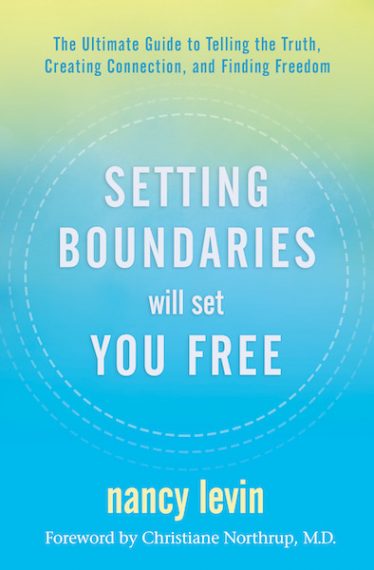When you find yourself being pushed around or walked over, you probably have failed to set, or enforce, boundaries in your life. Every one of us has allowed others to take advantage of our time, our energy, our space, mostly because we don’t like conflict and we want to be liked. Unfortunately, this pattern of behavior can be costly to our health and wellbeing.
Enter master coach, Nancy Levin with her new book Setting Boundaries Will Set You Free. This book is the antidote to worrying that setting boundaries will cause conflict. Instead, Levin demonstrates through personal and client scenarios how developing the boundary-setting habit is more doable than you think and much more liberating. From her own struggles with enforcing personal boundaries, she shares how her life was headed in a direction that deeply threatened her personal relationships and her own health. Only when she decided to say “no” and accept the accompanying short-term discomfort was she able to vastly transform her life and have long-lasting positive results.
I had to stop saying yes to other’s needs, wants, and desires in order to be loved and accepted. It meant I had to learn how to tell the truth and create connections with others in a more authentic way.
This book walks you through the ten steps to setting boundaries and is designed to help you shed related concern and muster the courage to take back your life. This starts with defining a boundary as where you end and another person begins. It also includes learning to listen to the formerly suppressed information that our minds and guts are warning us about regarding our personal limits. She says that each time you set a boundary you are saying “yes” to you.
And that isn’t selfish.
Rather it’s what’s needed in order to thrive and help others thrive too. And making yourself a priority is a revolutionary thought when your life has been dictated by codependency. Even subtle reliance exists in each relationship and those can be unwillingly nudged or manipulated in a way that becomes toxic.
For a relationship to survive, it needs to have a strong enough foundation to hold the truth of who each person is.
And her guidance is thorough, not permitting the opportunity for the reader to excuse out of a better life. For example, when you avoid setting boundaries there is most likely an underlying commitment standing in the way. If you choose to stay in an undesirable job and justify it with saying “you choose to make more money,” the underlying truth is your commitment to avoid “rocking the boat.” Coupling this pattern with unconscious beliefs can reveal a deeper resistance to change. And Levine doesn’t ignore the notion of guilt, but rather praises its occurrence in boundary setting as a signal that you’re finally breaking free of old patterns and honoring yourself.
This book is your cure to these destructive patterns.
And you’re not left alone to navigate this critical change. Levin offers support and real-time examples of how you can start softly setting small boundaries and growing bolder in your approach. Each chapter is dedicated to a step and hosts numerous exercises that challenge you to walk through the process with awareness and confidence.
I personally learned a lot about boundaries that are long overdue and those that I might be imposing on. It was incredibly eye-opening and supportive in personal change and something that I encourage those I care about and my clients to consider. She also challenges you to be comfortable with discomfort. But here’s the truth, if you’ve already conditioned yourself to live with discomfort and pain by not setting boundaries, the long-term freedom that comes with establishing boundaries now should far outweigh the challenge of change.
Image Courtesy of Hay House, Inc.


No comments yet.